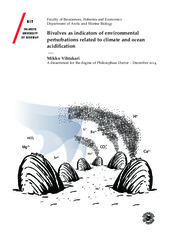Bivalves as indicators of environmental perturbations related to climate and ocean acidification
Permanent link
https://hdl.handle.net/10037/7152View/
Thesis introduction and appendix (PDF)
Paper I: Vihtakari, M.; Havenhand, J.N.; Renaud, P.E.; Hendriks I.E: ‘Variable individual- and species-level responses to ocean acidification’. (Manuscript). Also available in Frontiers in Marine Science 2016. (PDF)
Vihtakari, M.; Hendriks I.E.; Holding J.; Renaud, P.E.; Duarte C.M.; Havenhand, J.N. 'Effects of ocean acidification and warming on sperm activity and early life stages of the Mediterranean mussel (Mytilus galloprovincialis)'. Also available in Water, 2013, 5, 1890-1915. (PDF)
Paper III: Vihtakari, M.; Renaud, P.E.; Clarke, L.J.; Whitehouse, M.J.; Hop, H.; Carroll, M.L.; Ambrose Jr, W.G: ‘Decoding the oxygen isotope signal for seasonal growth patterns in Arctic bivalves’. (Manuscript). Also available in Palaeogeography, Palaeoclimatology, Palaeoecology 2016, 466(March):263–283. (PDF)
Paper IV: Vihtakari, M.; Ambrose Jr, W.G.; Renaud, P.E.; Locke V, W.L; Berge, J.; Cottier, F.; Hop, H.; Carroll, M.L.; Clarke, L.J: ‘Interpreting the seasonal environmental history recorded by Arctic bivalves'. (Manuscript). Published version, with title 'A key to the past? Element ratios as environmental proxies in two Arctic bivalves' available in Palaeogeography, Palaeoclimatology, Palaeoecology 2016. (PDF)
Date
2015-03-13Type
Doctoral thesisDoktorgradsavhandling
Author
Vihtakari, MikkoAbstract
The aims of this thesis were to increase knowledge on 1) susceptibility of bivalves to environmental perturbations and 2) usage of bivalve shells as sub-annual environmental proxy archives. These objectives were addressed using two experimental settings: 1) an ocean acidification (OA) experiment on bivalve gametes and early larval stages, and 2) year-long bivalve deployments on oceanographic moorings in two fjords in Svalbard followed by geochemical sampling of bivalve shells. The results indicate that Mytilus larvae are sensitive to ocean acidification, but global warming might have a larger impact on the larvae than acidification. Sperm activity of Mytilus galloprovincialis males was negatively affected by the high-end OA scenarios for the year 2100, possibly indicating a reduced fertilization success in low-density populations. Individual males demonstrated different tolerances of OA indicating that Mytilus populations might have the capacity to adapt to moderate reductions in ocean pH. Shell growth rate of Serripes groenlandicus and Ciliatocardium ciliatum correlated with temperature, and the length of the growth season was likely determined by food availability. Both species deposited a prominent winter growth line, which can be used as an indicator of low food availability. Despite the high potential as sub-annual environmental proxies, interpretation of elemental ratios in Serripes groenlandicus and Ciliatocardium ciliatum shells is complicated by multiple internal and external factors: Li/Ca could partly reflect calcium carbonate crystal growth rate, Mg/Ca was loosely connected with temperature, and Ba/Ca could reflect the elemental ratio in seawater. None of these ratios, however, can be used as straightforward proxies of temperature, salinity, fluorescence or shell growth rate. The insights into sub-annual growth of Arctic bivalves and the methods to align sample spots along chronologically deposited materials, as provided by this thesis, can be used in further proxy development studies.
Description
Publisher
UiT The Arctic University of NorwayUiT Norges arktiske universitet
Metadata
Show full item recordCollections
Copyright 2015 The Author(s)
The following license file are associated with this item:


 English
English norsk
norsk
